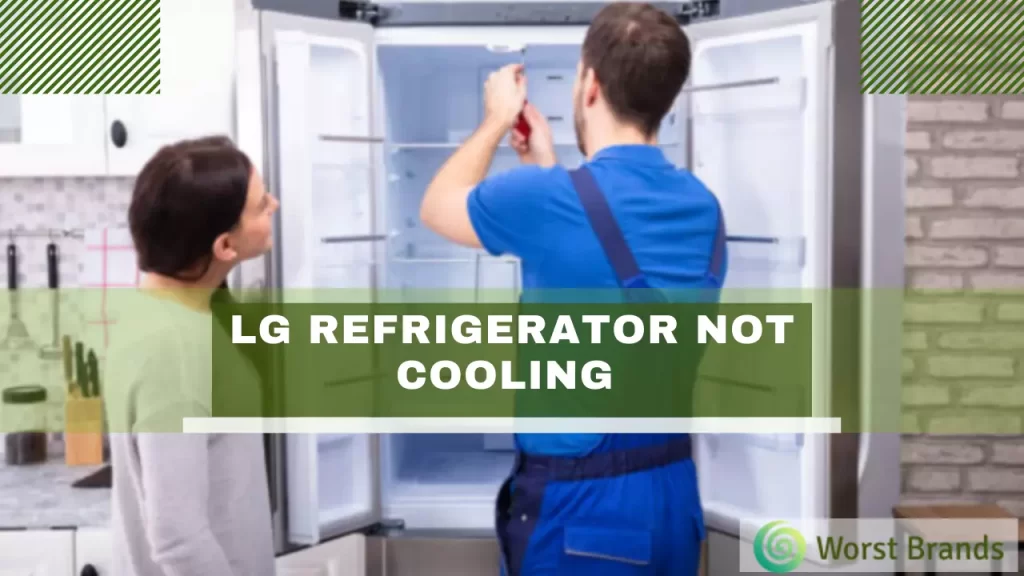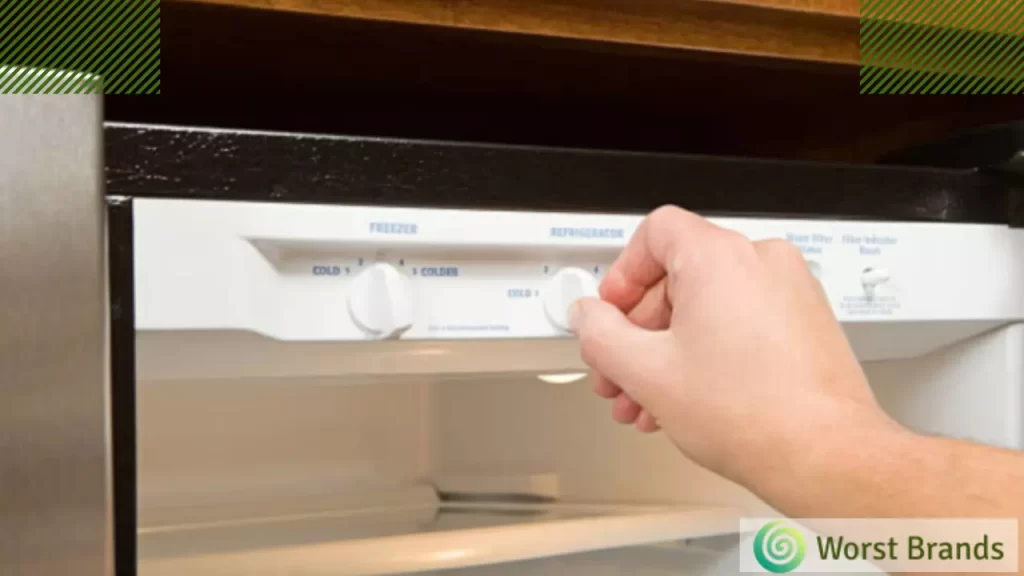LG is one of the leading manufacturers and sellers of refrigerators in the United States.
It has a lot of different types of refrigerators, and all of them have their own set of problems.
One problem that has been common for years is LG Refrigerator Not Cooling.
It may be quite irritating to have your phone ring nonstop with a repair person on the line.
Additionally, if your warranty has expired and the repair is expensive, it may not make sense financially to fix the issue with a big repair bill.
Therefore, to help you get rid of this LG refrigerator problem with some easy troubleshooting tips, we have compiled a list of the most common issues for the LG fridge that won’t cool.
Keep reading till the end to find out the real reason.
Table of Contents
- How to Fix LG Refrigerator Not Cooling?
- 1. Faulty Start Relay
- 2. Dirty Condenser Coils
- 3. Defective Condenser Fan Motor
- 4. Irregular Temperature Control Thermostat
- 5. Defective Temperature Control Board
- 6. Damaged Evaporator Fan Motor
- 7. Faulty Start Capacitor
- 8. Broken Thermistor
- 9. Electric issues with Compressor
- 10. Main Control Board Issue
- Conclusion:
- Steven Settles
How to Fix LG Refrigerator Not Cooling?
Common causes of LG refrigerators not cooling include faulty start relays, dirty condenser coils, defective condenser fan motors, faulty start capacitors, broken thermistors, and malfunctioning compressors.

Let’s take a look at each of these issues to see how you might troubleshoot them.
1. Faulty Start Relay
Faulty Start Relay just can’t start the compressor to get the perfect job, giving a tickling noise periodically.
It can also be due to improper current and voltage supply.
Solution:
- Unplug all the input circuits and give them time to cool down. Disconnect the water line if there is any connection.
- Check the continuity between sockets’ input and output terminals with the help of a multimeter.
- If there is continuity, you can just go next to check the temperature control thermostat.
- If the start relay has no continuity, it is advised to change it with the new component. If you notice any kind of fusty or burnt smell, replace the start-relay in this case as well.
- After this, reconnect the circuits back and reattach the water line if it is disconnected. Also, check whether the compressor is working or not.
2. Dirty Condenser Coils
The coolant flows through the coils and turns into a gas by boiling and exchanging heat from inside the refrigerators.
So, if there is a cooling issue in your electric gadget, it might also be due to the improper functioning of coils or condensers.
After long use, there might exist clogged dust and debris. Check out the following steps to have a solution.
Solution:
- Unplug all the connections and the waterline if it is attached.
- Condenser coils are beneath the refrigerator, and you have to access them from the back of the unit. So move the appliance to get a place if there is any need.
- Remove the dirt and debris with the brush or airflow. You can also use soapy water, but don’t forget to wait for complete draining.
- Wait for a few hours and check the temperature to see if it is getting down properly or not.
3. Defective Condenser Fan Motor
If the machine is still not working after cleaning the condenser coils, there might be a problem with the condenser fan motor.
The motor helps the airflow and exchanges the heat from the ingredients inside.
So, let’s get through the following points to get your motor inspected.
Solution:
- First, ensure the circuit’s disconnection and then get to the motor fan.
- Give the motor a complete clean if you see any dirt inside.
- Check the smoothness of flow by rotating the fan manually. It is most likely to be replaced if it doesn’t rotate well.
- Check the continuity of the motor with the help of a multimeter. If it does show continuity, there will be other issues than with the fan motor.
- If it doesn’t have continuity, it must be defective, and you must replace it.
4. Irregular Temperature Control Thermostat

Thermostats are used for setting different temperature settings.
It helps to set the desired temperature by controlling the input signals of the evaporator fan, condenser fan, and compressor by turning the knob.
So, if your refrigerator is not working according to your settings, the temperature control thermostat might require proper care.
Solution:
- Make sure to unplug all the wiring.
- Get to the thermostat that will be at the bottom of the refrigerator.
- Firstly, turn the knob. If you hear the clicking sound during turning, the thermostat is working, and you may go forward to test the next component.
- If you don’t hear the sound, check the continuity of the thermostat’s terminals with the multimeter. If it has continuity, the thermostat is working well. If it doesn’t have continuity, the component will be faulty, and you can contact LG to get the replacement of the part.
- Once you get the new component, plug back the circuit after installing it and check if it works.
5. Defective Temperature Control Board
The temperature control board is another leading component of temperature maintenance.
It examines the temperature sensors and gives the compressor and motor fans the starting signals to cool the unit.
So the cooling problem might also be due to a defective Temperature control board.
Solution:
- Having a faulty temperature control board is not a common problem. So make sure that you have checked all other major problems.
- If you don’t find any issue with other components, go for the replacement of the temperature control board with a new one.
6. Damaged Evaporator Fan Motor
It is another fan motor that circulates the air. It is normally placed behind the freezer or refrigerator at the back of the panels.
The evaporator fan motor cools the refrigerator by flowing the air through the coils to the inside sections.
So improper moving of the fan motor will cause your refrigerator a cooling problem.
Solution:
- Unplug all the input circuits to stay secure from any harm.
- Get to the evaporator fan motor and check for any dust and debris. Give it a smooth clean with a brush or any suitable thing.
- Try to turn the fan manually to check the free movement of the motor fan.
- Now check the wiring connection of the motor with the help of a multimeter. If there is a sign of any fault in the continuity, consider the replacement of the component.
- Detach the power wires of the motors and remove them by separating the mounting belts holding the motors.
- Place the new motor and button back all the connections to see the proper functioning of the cooling system.
7. Faulty Start Capacitor
The unsuitable functioning of the start capacitor can also cause insufficient cooling of the refrigerator.
Like the start relay, the start capacitor helps the compressor in the start-up voltage supply.
So, faulty capacitors will surely affect your unit’s cooling system.
Solution:
- Check to be sure that all the electric supplies are plugged out.
- Get the capacitor and check its functioning by means of a multimeter.
- You can move to the next component if it shows continuity. But if it cannot show the proper continuity, the capacitor will be defective, and you should consider replacing this part.
8. Broken Thermistor
A thermistor has a key role in cooling because it detects the temperature and then sends the readings to the control system.
It restricts the refrigerator’s temperature within a limited range and puts the cooling cycle in position when it rises to a certain level.
So you can’t expect proper cooling without a perfect thermistor.

Solution:
- Turn off all the circuits of the refrigerator.
- Locate the thermistor. It is basically located under a small plastic cover on the back wall.
- Check the working of the thermistor with the help of the multimeter. If it has continuity, the problem will be somewhere else.
- If it does not show the correct continuity, contact LG to find a replacement for this component. Mostly, the thermistor can’t be repaired.
9. Electric issues with Compressor
A compressor acts as a heart in the refrigerator’s cooling system. It allows the refrigerant to circulate throughout the system and boosts the vaporized refrigerant’s pressure and temperature.
So, a faulty compressor might be a major cause of the improper working of the cooling system.
You can have your freezer cold by decreasing the temperature, but the fridge section is warmed.
But this is not a common issue in the starting years of purchase. So check for the minor components of the compressor before.
Adding more, most LG refrigerators have a warranty of ten years. So before any major step regarding the compressor, check the warranty life and contact LG customer service.
Solution:
- Plug out all the supplies of compressors
- After examining all other possible problems, take out the compressor and check its continuity with a multimeter. Is it done between the terminal pins you find on the side of the compressor?
- If you detect any improper functioning in this test, consider the replacement of the compressor. At last, don’t try to repair it by yourself unless you are a qualified or professional technician.
How do I know if my LG refrigerator compressor is bad?
To know if the compressor is bad, look for any signs of leaking or failure, including excessive noise or water condensation in the freezer compartment.
10. Main Control Board Issue
If you are tired of checking all other components, the main control board will be the last option to test.
But it is not a common occurrence. However, it might be defective in many cases.
A malfunctioning control board can also cause LG refrigerator ice maker problems.
Solution:
The best option for this problem is replacing the main control board. But if the situation is reached at this point, replacing the complete refrigerator unit will be the best solution.
Conclusion:
LG includes the best brands of electric home appliances, but it is common to have minor issues after years of using electric devices.
We have tried to discuss all the possible causes and solutions for the LG refrigerator not cooling problem.
Firstly, you can reset the refrigerator to refresh it by turning the power supply off for two minutes. But if you detect some serious fault in the gadget, make a call to the
LG to get a professional technician. It also advised selecting the perfect refrigerator model to avoid the small issues that often occur in the old models.

Steven Settles is an ISCET-certified master in appliance repair. He has aced the National Appliance Service Technician Certification Exam, showcasing his exceptional diagnostic and repair skills. With an in-depth understanding of the latest repair technologies and a keen eye on evolving industry standards, Steven is a go-to expert for any appliance issue.